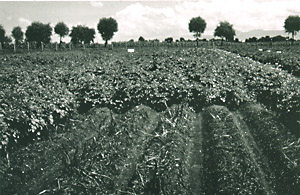from
Plant Diseases: Their Biology and Social Impact.
Protecting Potatoes from the Blight
Scientists had come to a consensus about the cause of the blight, but they still had no solution to the problem of saving the potato crop from invasion by the fungus. Protective copper fungicides still lay in the future, so that the poorest Europeans went hungry in the blight years that occurred periodically. According to Carefoot and Sprott in their interesting book Famine on the Wind, the last major famine due to P. infestans resulted in 1916 in the deaths of 700,000 German civilians, who were unable to protect their potato crop because the copper was needed for bullets rather than fungicides. Even today, more than 150 years after the Irish epidemic, frequent applications of fungicides are necessary to grow potatoes in moist climates, and losses occur even in Israel and the drier western United States. Potatoes remain a chemically intensive crop despite years of study of P. infestans and the disease it causes.
The search for potato cultivars resistant to infection by P. infestans remains an important goal. For years, farmers have selected potato plants that survived blight better than others, and more potatoes were collected in South America in an attempt to find blight-resistant plants. Although some cultivars were more resistant than others, no potatoes could survive cool, rainy blight years without fungicides.
In the first half of the 20th century, plant breeders were able to transfer resistance genes from a closely related plant, Solanum demissum, that had been collected in Mexico. They cross-pollinated the plants, harvested the seeds, and selected the most blight-resistant plants. Eventually, new cultivars were created that remained blight-free even when deliberately inoculated with the fungus. Some plant pathologists believed that late blight had been eliminated. Unfortunately, the success did not last. Within a few years, new races of the fungus appeared that were capable of infecting the resistant plants. Farmers reported that the resistance had "broken down," but, in reality, the fungus had "overcome" the resistance through genetic change. For some years, S. demissum remained an important source of resistance genes, but each time a cultivar with a new resistance gene was planted, it was only a matter of time before the fungus would develop a new race and cause a disastrous epidemic. This boom-and-bust cycle in the use of resistance genes has been observed in many important crops. Plants with resistance to nearly every important disease have been produced in breeding programs, but the production of plants with durable resistance remains a difficult challenge, which will be considered more fully in Chapter 5.

Fig. 1-17. Potatoes with resistance to Phytophthora infestans survive an epidemic better than the blighted susceptible cultivar in the foreground.
Introduction
The Arrival of the Potato in Europe
The Potato Plant
The Components of the Epidemic
The Birth of Plant Pathology
Protecting Potatoes from the Blight
Lessons from the Potato Famine
Selected Readings
RETURN TO APSnet FEATURE STORY
